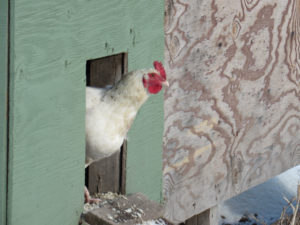DELAWARE chickens were developed by George Ellis in 1940- yes, in the state of Delaware- and were one of the breeds used for the production of broilers. The breed originated from crosses of Barred Plymouth Rock roosters and New Hampshire hens. The Livestock Conservancy currently lists them as “Threatened.”
Mr. Ellis’ goal was to develop a white feathered dual-purpose bird, one that would maintain good egg production yet increase meat production, too. Delaware was set to be the choice of broiler industry and was indeed popular for 15 to 20 years until the ultra-fast growing Cornish Rock cross exploded on the market. Because Delaware was bred for the broiler industry, very few homesteads kept them so they entered a period of steady decline. In 2009, The Livestock Conservancy had them listed in “critical” status.
With a moderately long, broad, and deep body, and laying 180-260 large brown eggs per year, Delaware makes an excellent dual-purpose bird. They have moderately large combs- so watch for frostbite in cold winter climes- and medium-sized head and neck.
They have a friendly disposition, although the roosters are not known for being nice guys (which we can attest to), and are noted for rapid growth and fast feathering of the chicks. They are cold hardy, non-flyers, and good foragers yet stick close to home. Some hatcheries say they are broody, we certainly hope so! A big advantage for free-ranging birds is that Delaware chickens are noted as being very predator-wise.

